The coyote obviously had crane cutlets in mind for breakfast but the cranes seemed to be taunting him, even daring him to attack. The attitude and demeanor of the cranes seemed to say “Give it your best shot, Buster”.
Yesterday morning in the mountains I witnessed a tense encounter between a coyote and three, later four, Sandhill Cranes. The eight photos below document that encounter even though the first four shots are a little soft, possibly due to operator error in all the excitement. All photos are presented in the order they were taken.
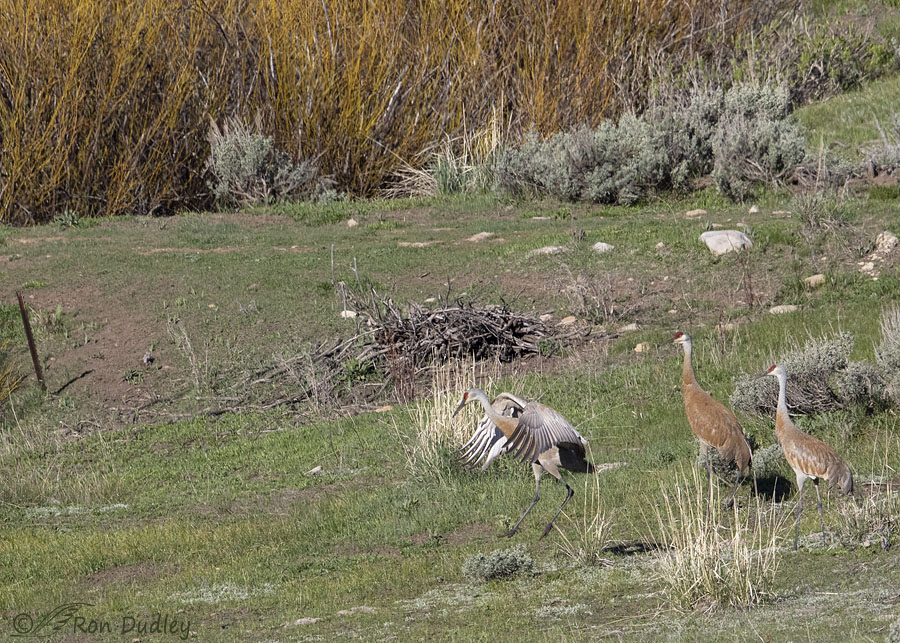
At first the coyote was mostly hidden in the willows in the upper background but the three cranes were very aware of ‘his’ presence. The two adults on the right were wary but calm but the presumed younger crane on the left displayed on and off throughout the encounter.
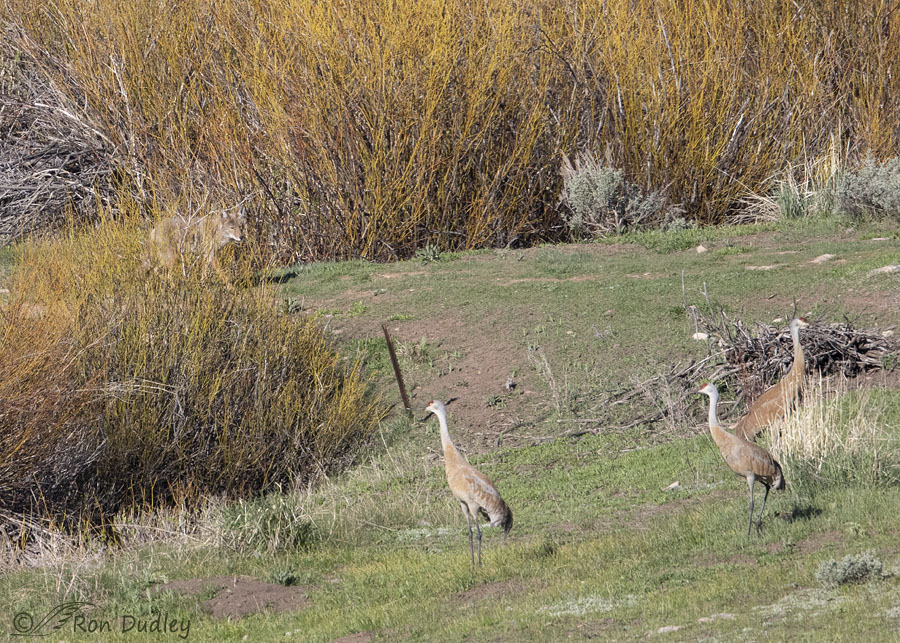
Soon the coyote came walking slowly out of the willows heading almost directly toward the cranes. At first the cranes took it in stride but eventually as the coyote got closer they…
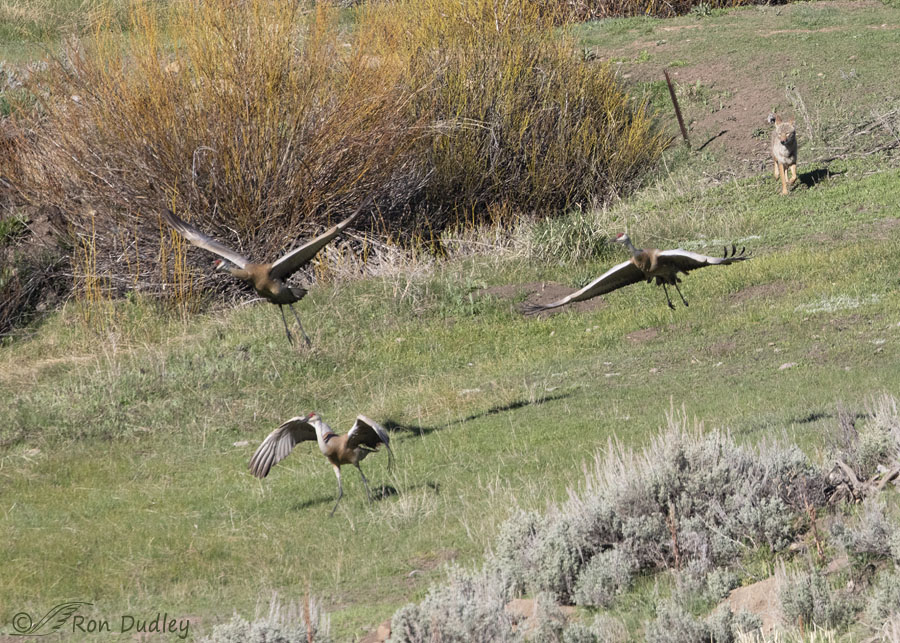
took flight. But they didn’t go far, only about 100′ or so before they landed again and it was there that they apparently decided to stand their ground.
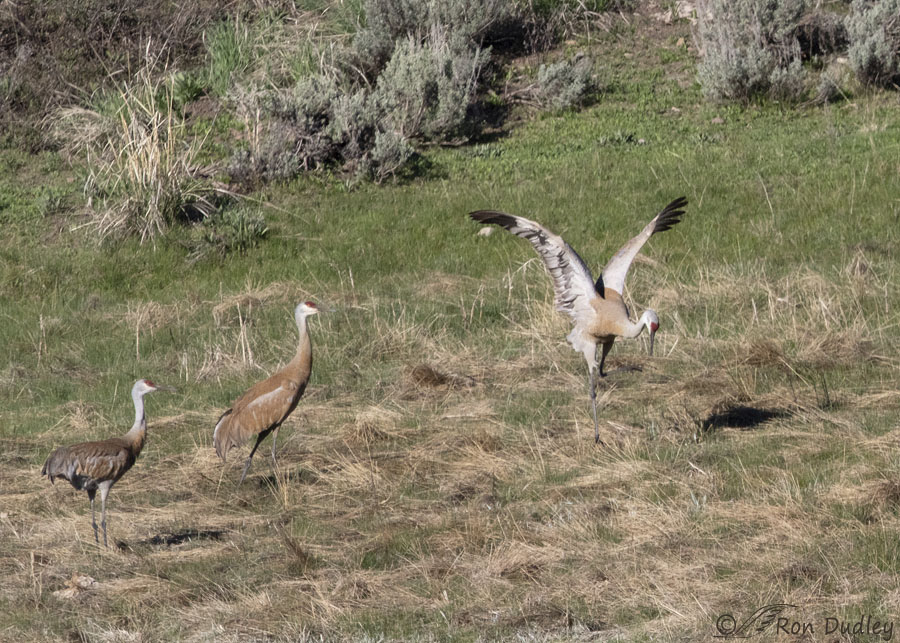
As the coyote approached them a second time the youngster continued to display but the adults were much calmer as they watched him…
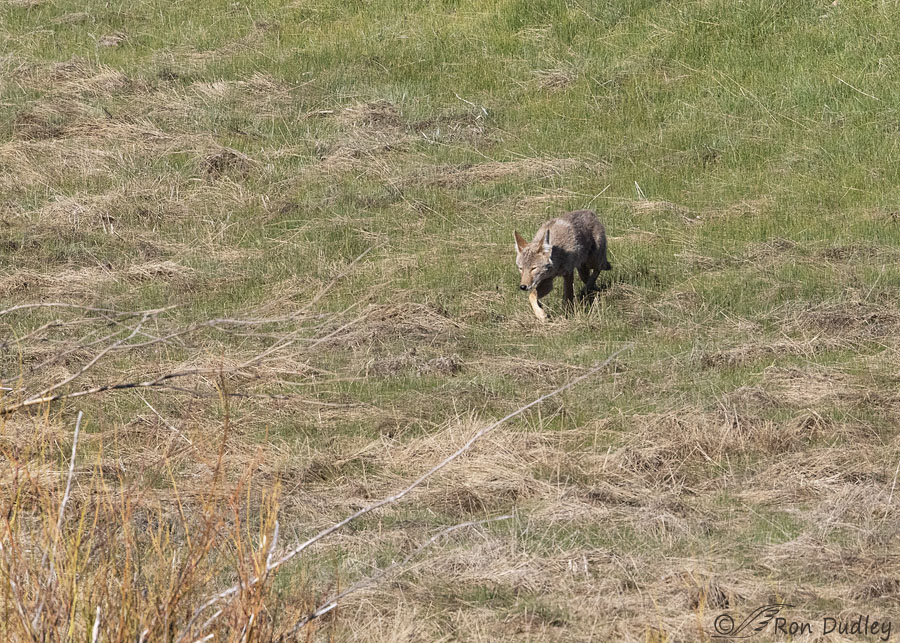
slowly get closer.
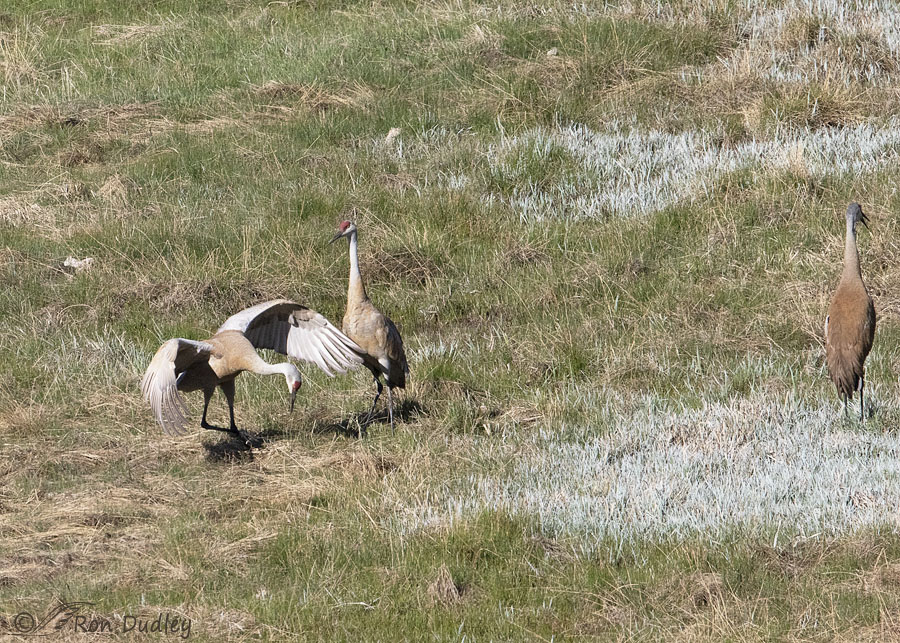
The coyote was pretty sneaky about his intentions as he approached. At this point he wasn’t walking directly toward them, instead he was circling around, eventually coming between me and the cranes. He often seemed to be ignoring the cranes by looking away from them but it was obvious to me that he wanted nothing more than crane for breakfast.
Of course the problem was getting close enough to make a successful attack before the huge lumbering cranes could get off the ground and fly off to safety.
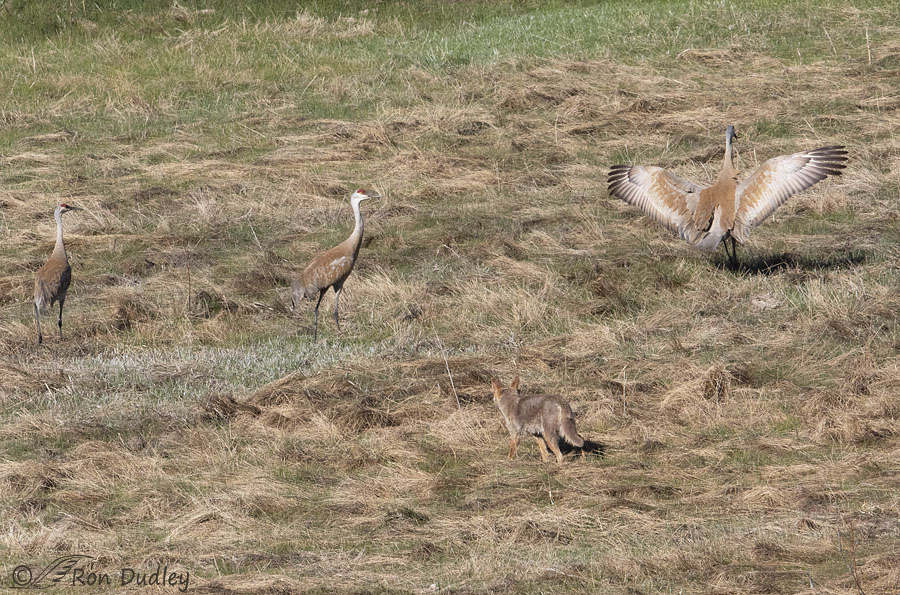
I was flabbergasted by how close the cranes let the coyote get to them. Even with the coyote this close the adults remained calm and watchful while the younger bird continued to act up.
It was obvious to me that all players in this little drama knew precisely how close the coyote would have to get to make a successful attack as the cranes walked slowly in front of the coyote and maintained that distance with what seemed to me like only inches to spare. I actually had the feeling that the cranes were taunting the coyote, even daring him to attack. They could have flown off many times but they chose to stand their ground.
Not long before this shot was taken I could hear a fourth crane in flight approaching from the south. Crane #4 could obviously see the coyote below him but he landed next to the other cranes as if he wanted to join in the ‘fun’.
In this shot there are actually four cranes in the group but with my long lens I could only fit three of them in frame.
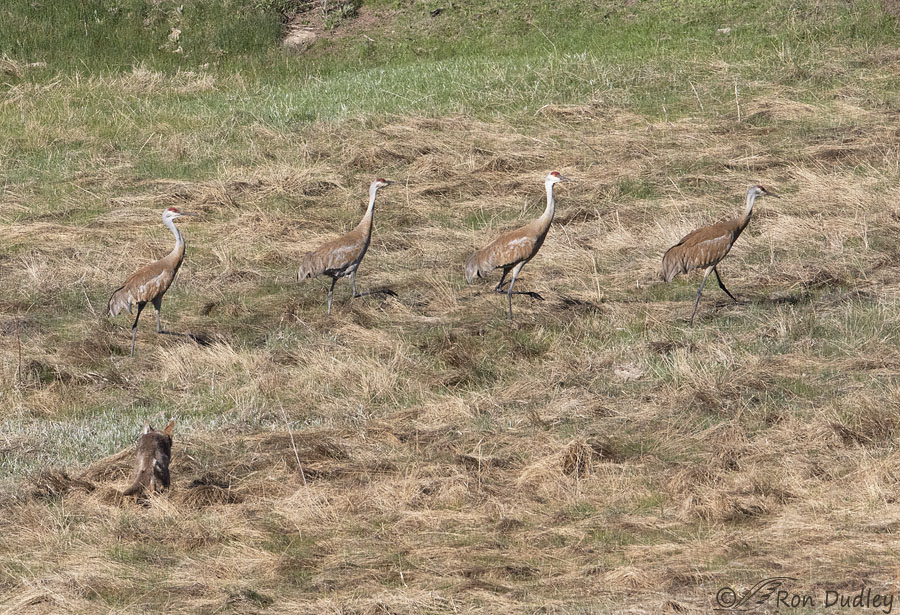
Now we can finally see all four cranes with the coyote very close to them at lower left.
I spent almost 16 minutes watching this little drama unfold but the coyote never did rush the cranes who continued to calmly keep almost this exact distance between them and their potential killer whom they appeared to be toying with. So, difficult as it may be to believe, I eventually decided to leave the coyote and the cranes behind and look for other critters to photograph before the sun got too high in the sky for good nature photography.
Later in the morning just before I drove by the same spot I wondered if I’d find nothing left of one of the cranes but a huge pile of feathers but there was no evidence in the area that any of the participants had ever been there.
Yes, I was relieved – both for the cranes and for myself as a nature photographer who would have made the wrong decision and missed experiencing and documenting the attack that would have killed one of the cranes.
I’d have been uncomfortable watching it but I’d hate to have missed it.
Ron
An interesting note:
My friend Jay Banta was manager of Fish Springs National Wildlife Refuge in remote western Utah for many years. Jay made the following comment on my link to this post on Facebook: “However the coyotes are far too often successful in much of greater Sandhill range. In 15 years of having 1-2 nesting pairs at Fish Springs there were only 2 colts that made it to fledging.”


Exciting encounter! It reminds me of a coyote-Snow Goose interaction I witnessed at Bosque del Apache in New Mexico. While one coyote walked out in front of a very large flock (acting like your subject), the other was sneaking up from behind. The latter made a rush and nearly the entire flock rose up into the air, calling loudly. I did not see that the coyote had any success but it was a very busy, noisy and crowded scene for several minutes afterward..
Great series! I once had a group of 10 turkeys, adults and polts, walking through the woods all in a row. They spotted a coyote stalking them and immediately formed a defensive circle and stayed that way until the coyote made a final lunge. At that point, they all flew into the trees.
Definite drama! I’d have gotten the hell out of Dodge had I been a crane, though. I hope the Coyote was able to get some kind of breakfast, even if it wasn’t crane-under-paw.
I feel the same way, Marty – if push had come to shove I’m not sure who I’d have been rooting for.
So interesting the young are called “colts”. I’m a horse nut so surprised to hear the name for a young male horse used for these cranes!
Thanks so much!!
Yup, colts is what they’re ‘officially’ called, Mary.
More amazing choreography – with the potential for dangerous missteps. I wonder of course just how serious the coyote was, but the dance had to occur to test that resolve.
What a privilege to see, and a privilege for us too.
I’m glad you enjoyed it, EC. Thanks.
I think that is either one very hungry or a very inexperienced coyote. I knew someone many years ago who studied Sandhill Cranes. Many young were taken by coyotes but adults, unless injured, were never taken. In his nearly 20 years of studying cranes he twice saw coyotes killed by adult cranes.
Dan, so maybe they were being careful of each other for very good reason. An actual skirmish could have gone either way.
I once saw 2 coyotes working as a team– one of them out in the open
moving toward the prey, while the other waited , half-hidden in scrub
hundred or so yards away…..the visible coyote moved in the direction of
the concealed one,”pushing” the alerted prey towards his partner–they
clearly had practice in this maneuver ! As the intended prey was a small
dog, I made a racket and broke up the progress of what was clearly no
“game”
Wow.
It looks to me in the last photo like the Cranes might be circling in for the kill. Maybe the next time you’re up there you should look for a pile of fur.
Lyle, I was sitting in a doctor’s examining room when your comment email came in. I rarely smile in a doctor’s office so thanks for that one.
Great series, Ron. The coyotes do have a lot of different “tactics” when stalking prey. Here “turn about is fair play” (sort of) when the Magpies spot them – no escape and any skulking around is “done”…..
The coyotes do have a lot of different “tactics” when stalking prey. Here “turn about is fair play” (sort of) when the Magpies spot them – no escape and any skulking around is “done”…..
Judy, I can’t imagine a better ”watchdog’ for the entire community than magpies.
Such a suspenseful post! I really appreciate the educational factor and each post seems to add to it.
Good. Thanks, Jamila.
Interesting theory by Dick, but I don’t think coyotes have time for games. Very interesting series Ron. I think all of your followers enjoy these educational action series. We had eight Cranes visiting for about a month during the winter months. I would often very quietly approach them near one of our lakes always in wide open areas. Each time I would try to get a little closer they would pick up and move. Never ever panicked, mostly would just walk away, and then a couple times I would continue on to see what they would do and they would fly off, but only move maybe 25 yards or so. Even if the coyote rushed them all he would even have a chance at would be those long trailing legs and he would have littler chance of holding onto one of those. I have no doubt they knew what they were doing.
Thanks, Everett. I envy you having cranes around in the winter.
Any thoughts on the age/experience level of the coyote? Seems like a complete waste of time and energy to pursue cranes who were obviously onto him. In the high arctic the hares will stand straight up and still and obvious when they see a wolf. The message there is clear. “I see you, so don’t waste your time trying to catch me.”
Maybe this was a young coyote either practicing or ignorant.
I’m not sure about age, Porcupine.
There could be several other explanations too, including testing the cranes for one that might seem injured or unhealthy and the possibility that the cranes were attempting to lead the coyote away from their nest.
Wile E. Coyote has given up on roadrunners. But I think maybe he should just remove poultry from his diet altogether.
What was the f-stop of the last photo where you managed to get the birds AND coyote relatively in focus? Thanks for this documentary episode.
I have watched coyotes in my area do this with wild turkey. Generally the birds are pretty verbal and quite fast. I’ve never seen a coyote manage to catch one, even when there are young birds present.
I’ve noticed the unspoken dictum of animal survival is “power in numbers” so it was 3 against 1, and the coyote knew its odds worsened when the 4th bird showed-up.
Interesting thought, Terri.
Very interesting, but I wonder whether the coyote was also toying with the Cranes. I think humans put too much thought into scenes like this. I have to believe if the coyote’s stomach was full he was also having some fun with the Cranes. Just my take!
“I wonder whether the coyote was also toying with the Cranes”
Could be, Dick. Hard to know for sure what the intentions of all of the participants was.
Interesting encounter! I can’t believe they stayed, letting him get so close. Leave it to ‘Jr’ to strut about…just like a teen-ager! They do not seem to get airborne quickly but they must know they could do it. I would not have wanted to watch if one didn’t I must say.
Yup, it would have been very hard to watch but if it was going to happen I sure would have wanted to have my lens pointed their way. Thanks, Kathy.